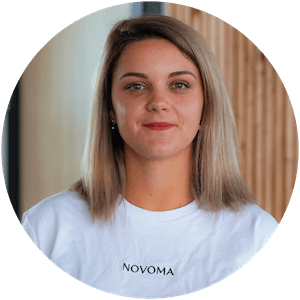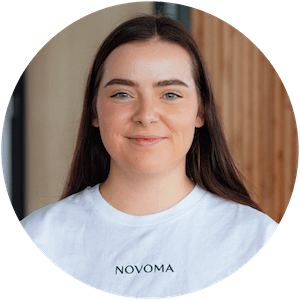
Learning to Love Yourself and Break Free from Societal Pressures, Our Vision and Advice
Summary
As summer approaches (and throughout the year, really), the pressure to achieve “perfect bodies” can weigh heavily on emotional well-being. You’ve probably noticed that the term Body Positive movement has taken over magazines and social media in recent years.
👀 This term, somewhat overused, is not always properly understood by those who have adopted it. Since body image is closely linked to personal well-being, we’d like to set the record straight (and adjust the standards of beauty too). ☝️
What is Body Positive?
Everyone talks about it, but do you know how to clearly define the Body Positive movement?
While online content is filled with misunderstandings and misinterpretations, it’s time to go back to basics!

Definition, Origin, and Evolution of the Body Positive Movement
According to some online articles (and social media), the Body Positive movement was created in the late 90s, specifically in 1996, by two American women: Connie Sobczak and Elizabeth Scott, respectively a writer and a psychologist.
The two women launched the Body Positive organization after the death of Connie’s sister, who suffered from eating disorders. Having herself recovered from an eating disorder, Connie decided to fight against societal beauty standards, particularly those related to women’s bodies.
Their goal? To help as many people as possible develop a healthier relationship with their bodies and food and challenge societal beauty norms (especially for women).
However, the Body Positive movement (without capital letters) dates back to the Fat Acceptance Movement, initiated in the late 60s in New York. Their mission was to actively challenge the norms surrounding body size and fat. A deeply feminist movement, it emerged alongside civil rights struggles (like Black Power).
Today, though, social media and numerous brands have embraced Body Positivity, with varying degrees of authenticity.
The Body Positive Movement Challenges Societal Norms
Whether it’s the organization launched in 1996 or the Body Positive movement from the Fat Acceptance Movement in the 60s, the goal is essentially the same: to strive for self-acceptance and body positivity.
➡️ The Body Positive organization focuses on self-love, a healthy and peaceful relationship with one’s body and food, and liberation from the pressures of thinness, regardless of body size.
➡️ The body positive movement originating from the Fat Acceptance Movement is more political and aligns itself with other struggles against oppression (classism, racism, sexism, ageism, financial exploitation, imperialism, etc.). The Fat Manifesto strongly opposes “slimming” industries:
Weight loss centers,
Diet books and products,
Diet foods, slimming products, or appetite suppressants.
Novoma aligns with this perspective. Taking care of yourself should not be tied to controlling your body. Our article on the myth surrounding probiotics for weight loss might interest you. 👌

Body Positive and Self-Acceptance: A Long Journey
The culture (and time) we live in is marked by beauty trends and changing standards. As we know, our generation is defined by the omnipresence of social media and the worship of flawless, muscular, and perfect bodies—quite far from the Body Positive movement! And this has consequences for our mental well-being.
Retouched Images, AI, and Thinness Ideals... How to Embrace Body Positivity?
Retouched images or AI-generated content, filters on social media: adopting a healthy relationship with your body and food has become a real struggle amid societal pressures.
The first people affected by these images? Young teenagers, who are exposed to screens and social media earlier and earlier.
📊 Statistics don’t lie: A 2022 meta-analysis from the University of Bordeaux, which gathered results from 30 scientific studies, highlighted the impact of social media on body dissatisfaction in teenagers:
Social media use and frequency are associated with:
Lower appearance and weight satisfaction,
Depressive tendencies,
Dietary restrictions,
Muscle-building behaviors (among boys),
Weight loss attempts (among girls), and emotional difficulties.
Not to mention the amplification of exposure to retouched, ultra-muscular, and flawless bodies, thanks to our beloved algorithms. The Minitel era seems far away... 😶🌫️
Furthermore, the Body Positive movement is now widely used on Instagram, particularly by relatively slim individuals showcasing what they consider to be flaws, such as cellulite. Fat Acceptance Movement advocates see this as an overrepresentation of “slim” people at the expense of their cause.
➡️ According to us, the first step to improving body image and embracing a Body Positive mindset is to review the content we are exposed to!
Fortunately, some inspiring figures promote body diversity and acceptance, especially on Instagram.

Whether it’s the organization launched in 1996 or the Body Positive movement from the Fat Acceptance Movement in the 60s, the goal is essentially the same: to strive for self-acceptance and body positivity.
➡️ The Body Positive organization focuses on self-love, a healthy and peaceful relationship with one’s body and food, and liberation from the pressures of thinness, regardless of body size.
➡️ The body positive movement originating from the Fat Acceptance Movement is more political and aligns itself with other struggles against oppression (classism, racism, sexism, ageism, financial exploitation, imperialism, etc.). The Fat Manifesto strongly opposes “slimming” industries:
Weight loss centers,
Diet books and products,
Diet foods, slimming products, or appetite suppressants.
Novoma aligns with this perspective. Taking care of yourself should not be tied to controlling your body. Our article on the myth surrounding probiotics for weight loss might interest you. 👌

Body Positive and Self-Acceptance: A Long Journey
The culture (and time) we live in is marked by beauty trends and changing standards. As we know, our generation is defined by the omnipresence of social media and the worship of flawless, muscular, and perfect bodies—quite far from the Body Positive movement! And this has consequences for our mental well-being.
Retouched Images, AI, and Thinness Ideals... How to Embrace Body Positivity?
Retouched images or AI-generated content, filters on social media: adopting a healthy relationship with your body and food has become a real struggle amid societal pressures.
The first people affected by these images? Young teenagers, who are exposed to screens and social media earlier and earlier.
📊 Statistics don’t lie: A 2022 meta-analysis from the University of Bordeaux, which gathered results from 30 scientific studies, highlighted the impact of social media on body dissatisfaction in teenagers:
Social media use and frequency are associated with:
Lower appearance and weight satisfaction,
Depressive tendencies,
Dietary restrictions,
Muscle-building behaviors (among boys),
Weight loss attempts (among girls), and emotional difficulties.
Not to mention the amplification of exposure to retouched, ultra-muscular, and flawless bodies, thanks to our beloved algorithms. The Minitel era seems far away... 😶🌫️
Furthermore, the Body Positive movement is now widely used on Instagram, particularly by relatively slim individuals showcasing what they consider to be flaws, such as cellulite. Fat Acceptance Movement advocates see this as an overrepresentation of “slim” people at the expense of their cause.
➡️ According to us, the first step to improving body image and embracing a Body Positive mindset is to review the content we are exposed to!
Fortunately, some inspiring figures promote body diversity and acceptance, especially on Instagram.

Inspiring Figures Who Ground the Body Positive Movement
While some influencers attempt to co-opt the Body Positive movement for commercial purposes, several inspiring figures are contributing, in their own way, to changing perspectives on beauty representation:
The American comedian Celeste Barber with her hilariously offbeat humor.
The account Eff Your Beauty Standards, a community platform advocating for the fat activist movement.
Ninah Bulles, a lifestyle blogger and seamstress, known for her handmade, Body Positive creations.
Other accounts have embraced the Body Positive movement, but the real work begins within ourselves, daily. 😌
Our Tips for Embracing Body Positivity
Our vision of the Body Positive movement? It’s about distancing yourself from pressures related to weight and beauty and gradually learning to celebrate your whole self through a lifestyle that honors the body and enhances emotional well-being.
A Balanced Diet Full of Flavors
According to the Body Positive principles, food should not be synonymous with dieting, restriction, or guilt, but with pleasure in service of well-being. Goodbye boring chicken-and-broccoli meals.
How to cultivate a healthy relationship with food?
✅ Honor your body’s needs by incorporating nutrient-rich foods: omega-3 fatty acids for nervous system balance and cardiovascular health, fresh seasonal fruits and vegetables, quality proteins, and more.
✅ Follow intuitive eating principles: respect your appetite by listening to your body’s hunger and fullness cues… which also means knowing when to stop.
✅ Take the time to eat with mindfulness and pleasure: use mealtime as a moment to slow down, whether you’re dining alone or with others.
✅ Embrace moderation: it’s always excess that’s the poison!
The Body Positive movement encourages us to develop a healthy relationship with food, understanding that every food has its place in our diet and that meals should never become a source of stress!
We recommend
Ashwagandha Bio
Formula made from pure organic Ashwagandha root extract, KSM-66® patented.
- ✅ KSM-66® patented
- ✅ 500 mg of ashwagandha per capsule
- ✅ 5% withanolides
- ✅ Certified Organic by Ecocert
Enjoyable Physical Activity
The Body Positive movement advocates for daily physical activity. Well-being comes through movement, whatever form that takes: running, dancing, swimming, practicing yoga, dancing in your living room, walking... you name it.
In the context of Body Positivity, the idea isn’t to meet specific body standards but to find joy in movement, whether alone or with others! ⛹️
Personal Growth for Confidence and Emotional Well-Being
Building self-confidence and mental well-being are significant goals that are not easily achieved for many people!
Beyond the personal history that may cause inner struggles or lack of self-esteem (childhood, past relationships, life circumstances), self-confidence is a daily practice, especially in a society where stepping outside the norms isn’t always welcomed. In this sense, the Body Positive movement can help us all claim our space.
Our advice:
🧘 Integrate mindfulness practices to help ground yourself in the present moment without judgment: yoga or meditation can reduce anxiety and stress while improving well-being and self-compassion.
🧠 Take care of your nervous system: your emotional tolerance is directly linked to how well-regulated your nervous system is, which requires a restorative sleep and, if needed, adaptogenic herbs to support emotional balance and boost the body’s resilience. Griffonia and Ashwagandha are part of this!
🫂 Don’t hesitate to reach out to a therapist for help in deconstructing limiting beliefs: emotional support can help you regain self-confidence and acceptance.
Thus, the Body Positive movement is not just about physical appearance; it’s about embracing self-acceptance and promoting a greater diversity of bodies. And between us: learning to love yourself is also learning to love others better…
FAQ
How to practice body positivity?
Engage in daily actions to take care of yourself and celebrate who you are: engage in physical activity, surround yourself with people who embrace body acceptance, filter the content you are exposed to, enjoy your meals, and incorporate relaxation techniques.
Why oppose Body Positivity?
According to some, anyone is legitimate in using the term Body Positive, regardless of their body size. For others, only underrepresented individuals with non-standard body types should be allowed to discuss it. The real question to ask is: what does Body Positivity represent for you!
Who invented Body Positivity?
Body Positivity originated from the Fat Acceptance Movement, born in the 1960s in the United States. It was later revived in 1996 by author Connie Sobczak and psychologist Elizabeth Scott.














